4 Types of Peanuts & Their Endless, Tasty Subtypes
Author: Anne Cowart | Editor: Omar Alonso
Review & Research: Jen Worst & Chris Miller
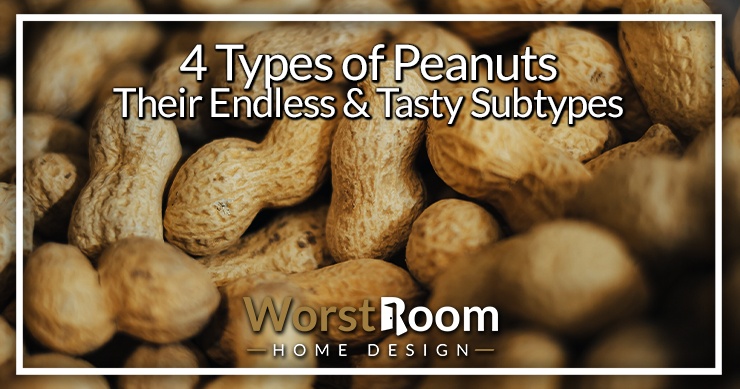
Unsurprisingly, the different types of peanuts are beloved across the world — from being the perfect complement to a cold beverage to forming the base of highly loved comfort food (PB&Js for the win!) or just being a great snack in its own right, peanuts are versatile, healthy, and delicious legumes.
What may come as a surprise, though, is the fact that there are quite a few peanut varieties out there. Fortunately if you're an aficionado you can actually get your hands on these and try most of them.
4 Types of Peanuts
Whether you want to learn about these out of your love for the nuts or to start farming your own peanuts, here’s a breakdown of the four major types of peanuts in the United States, as classified by the American Peanut Council.
Virginia Peanuts
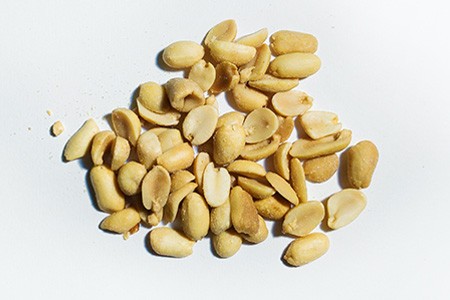
Known informally as “cocktail nuts” and formally as Arachis hypogaea, Virginia peanuts are the largest kernels of the lot.
As the name suggests, these peanuts are majorly grown in Virginia (in the southwest), but also in some regions of South and North Carolina, West Texas, Oklahoma, New Mexico, and Tennessee—all regions with a warm climate. Virginia peanuts account for 10-15% of all the peanuts in the American peanut market.
Many people avoid these peanuts due to the high levels of fat they contain, but it should be noted that the fat they contain is the healthy kind—HDL or high-density lipoproteins—that can actually aid in reducing cholesterol and its related health issues from taking a hold on the body.
Virginia peanuts are popular for their brittleness and unique flavor, apart from their size. However, the strong independent flavor that these groundnuts have can be a deterrent for some folks. That doesn't stop other people from using them even on desserts like various types of brownies.
This is why, despite their size, Virginia varieties of peanuts are not commonly used to make peanut butter. Their size also makes them quite difficult to process. Instead, these legumes are enjoyed salted, flavored, in-shell, or roasted.
At baseball games, especially, where they’re called “Ballpark peanuts”, you’ll find that these nuts have just as many fans as the home team and opponents put together, especially when they're boiled in salty broth.
Virginia peanut plants grow bunched or running, reaching maximum heights between 18 and 22 inches. They’re quite easy to grow even in home gardens, with a single harvest yielding quite a large number of nuts. Another unique feature of these plants is that they’re self-pollinating; they don’t require insects for pollination.
If you’re growing these types of peanuts at home, get your soil sufficiently tilled and plant the seeds during summer. Harvest them after a maximum of 110 days if you’re looking for boiling, still-green peanuts; if you want peanuts to roast, wait till they’re completely dry before harvesting, which means harvesting after a maximum of 150 days.
Some of the common sub-varieties of Virginia peanuts include:
- Sugg
- Wynne
- Champs
- Titan
- Phillips
- Gregory
- Bailey
- Sullivan
- Perry
- FloridaFancy
These different kinds of peanuts are all quite easy to get your hands on, so feel free to really stretch the limits and give them all a try.
Runner Peanuts
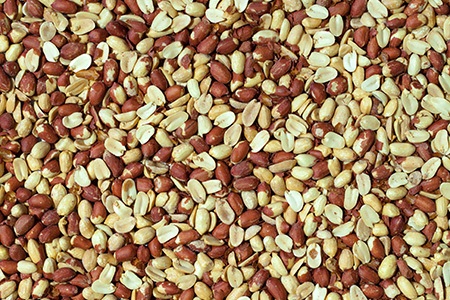
With a market share of 80%, Runner peanuts are the country’s most widely cultivated and sold peanuts.
It was in 1940 that farmers first noticed the variety. A large-scale shift to the farming of Runner peanuts occurred thirty years later, when the Florunner variety, with its high yield percentage, excellent flavor, and superb roasting features, was introduced.
Also known scientifically as Arachis hypogaea, Runners are majorly grown in the country’s southeastern regions, where warm temperatures are consistent, such as Oklahoma, Florida, Texas, Alabama, and Georgia, with the last accounting for 40% of the country’s Runner-peanut yields. A few areas in the southwest also cultivate the crop.
Apart from their flavor, Runner peanuts enjoy massive popularity due to their physical characteristics, whether that's whole or chopped up and sprinkled on types of fudge or ice cream.
Not only does the medium-sized build of these peanut types ensure easy processing and even roasting (and therefore, even flavor), but the kernels also look nearly identical to each other, which makes them more appealing to consumers, especially when packaged. The former quality, along with their flavor, makes them the go-to for peanut butter production.
In fact, as much as 54% of the country’s Runner yield is exclusively dedicated to making peanut butter. These types of peanuts aren't only the tastiest for the task, but their voluminous yields make it advantageous.
For those looking to cultivate Runner peanuts in their backyards, warm weather is a must, with full and direct exposure to sunlight and healthy, loose soil. These plants mature around the 150th day in their lifecycle (the growing season must be consistently warm without any frost or snow).
Some popular sub-varieties of Runner peanuts include:
- Egyptian Giant
- Bradford Runner
- Sunrunner
- Southern Runner
- Early Runner
- Dixie Runner
- Georgia Brown & Georgia Green
- Georgia Runner
- Flavor Runner
- Florunner
- Virugard
- The Tamrun varieties
All of these different peanuts come together to create the most popular group of peanuts out there, so hunt these different kinds of peanuts down knowing you’re very likely to find them. You can even find them in bags of mixed nuts along side types of almonds and pistachios and so forth.
Valencia Peanuts
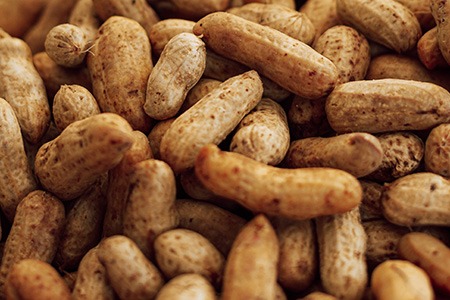
With merely 1% market share in the peanut market, Valencia peanuts are the country’s least-grown variety, outranked in demand by other varieties, possibly due to their small size. Despite that, these peanuts are the favorites when it comes to boiling, usually enjoyed boiled in-shell due to their extremely sweet, delicious taste.
This feature also makes them a great base for naturally sweet peanut butter, especially the homemade kind. Their sweetness combines with their naturally coarse texture, making them a great option for those who love coarsely ground, organic peanut butter.
Valencia peanuts, scientifically named Arachis fastigata, are majorly grown in the New Mexico region (the country’s primary producer), as well as in West Texas’s South Plains, in the regions to Portales’s south, and in a few parts of the country’s southern region.
Like all peanut varieties, these also require direct sunlight and constantly warm temperatures to grow and thrive.
Despite their small size, you’ll find that Valencia types of peanuts grow three or five to a pod, with the smooth, oval kernels packed extremely tightly into the shells. They have bright reddish skin and are also savored roasted.
You can buy these off supermarket shelves pre-cooked and ready to eat, shelled, or raw with their shells, to either roast, boil, or make peanut butter from at home. If you're lucky you'll find these peanut types in those assorted bags of nuts along with types of pecans, cashews, and other nuts.
Valencia peanut plants can grow quite tall, reaching a maximum height of 30 inches. You’ll find most peanut pods growing in clusters around the plant’s base and some on the upper parts. Unlike Runner and Virginia peanut plans, Valencia peanut plants mature by their 90th day of life.
The most common sub-varieties of Valencia peanuts include:
- Valencia C
- Georgia Red
- Tennessee Red
- Valencia A
Track down these different kinds of peanuts and you'll have explored pretty much all the Valencia varieties of peanuts have to offer you.
Spanish Peanuts
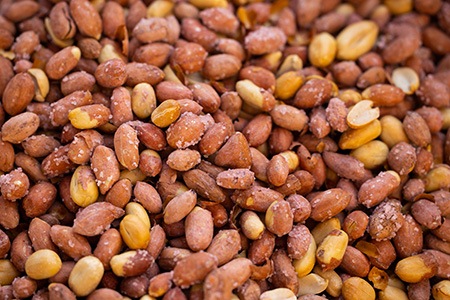
Rounding off our list of different peanuts are the Spanish peanuts. You can differentiate this variety from its cousins by its extremely high oil content (higher than other varieties), brownish-red skin, and tiny kernels.
Due to their oil levels, Spanish peanuts are a staple in peanut oil production, crushed to produce a range of heart-healthy peanut oils that are widely used in cooking. Ole Spanish peanuts, especially, first introduced in 2015 and featuring extremely high oleic acid levels (healthy monounsaturated fatty acids), are favorites in oil production.
Spanish peanuts are also popular as candies, peanut butter, salted nuts, ingredients in food items such as cookies and crackers, and snacks, as they have an elevated roasted peanut score that contributes to quite a long shelf life. In fact, after the Runner variety, Spanish peanuts are the most widely used in peanut butter production.
Additionally, their small size means that like Runner peanuts, these peanuts are also easy to process—easier, in fact—and quite popularly used in canned mixed-nut packages.
Though delicious even in their whole forms, it can be tedious to get the skin off each kernel before consumption, which is why this isn’t a preferred method of eating Spanish peanuts.
Though these types of peanuts accounted for 90% of the market share in the 1940s, Spanish peanuts only make up 2% of the country’s peanut cultivation today, with higher-yielding, hardier, and larger varieties capturing fields and markets.
Today, Spanish peanuts are majorly cultivated in Texas, New Mexico, and Oklahoma. Internationally, they’re also cultivated in South Africa. Scientifically, they’re referred to as Arachis fastigata.
Spanish peanuts grow in the same conditions that other peanut varieties grow in, in warm climes with ample sunlight and nutritious, loose soil. They take anywhere between 105 and 115 days to mature.
Some popular Spanish peanut sub-varieties include the:
- Tampspan 90
- Olin
- Shaffers Spanish
- Georgia-045
- Spanco
- Argentine
- Spanco
- Pronto
- Florispan
- Early Spanish
Of these, Early Spanish peanut types are the most commonly available and yields harvests quickly (as the name implies) in the right growing environment.
Red & White Peanuts
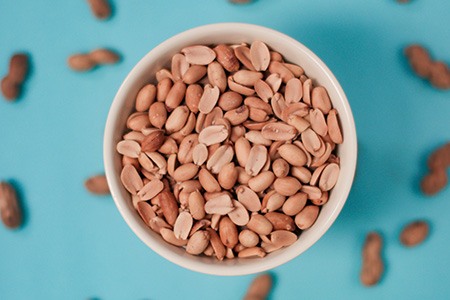
We should mention that some people also differentiate peanuts as red and white, based on the color of the kernel. These colors are a result of different maturity levels; lighter shades mean less matured legumes and vice versa.
Obviously, the more mature nuts are sweeter to the palette and also more beneficial to human health, rich in monounsaturated fats and antioxidants. White peanuts, also known as Baisha, are great for deep-frying and have an abundance of protein.
Another red and white distinction is between the Texas or Tennessee red and white varieties. Again, the differentiation is based on the color of the kernel, but these are varieties of peanuts. They’re quite alike the Valencia variety, except for green stems, smaller kernel yield, and irregularly shaped, rough pods.
Types of Peanuts to Satisfy Even the Most Nutty Fan
All types of peanuts, also known as groundnuts, goobers, and pindars, are enjoyed around the world. However, like all good things in life, peanuts are at their healthiest and tastiest in moderation. Remember, too much of a good thing can end up being bad.
Diarrhea, constipation, bloating, and a range of stomach issues accompany excess peanut ingestion. Therefore, whichever of the different types of peanuts you pick, always eat a reasonable amount (it's hard, I know).




